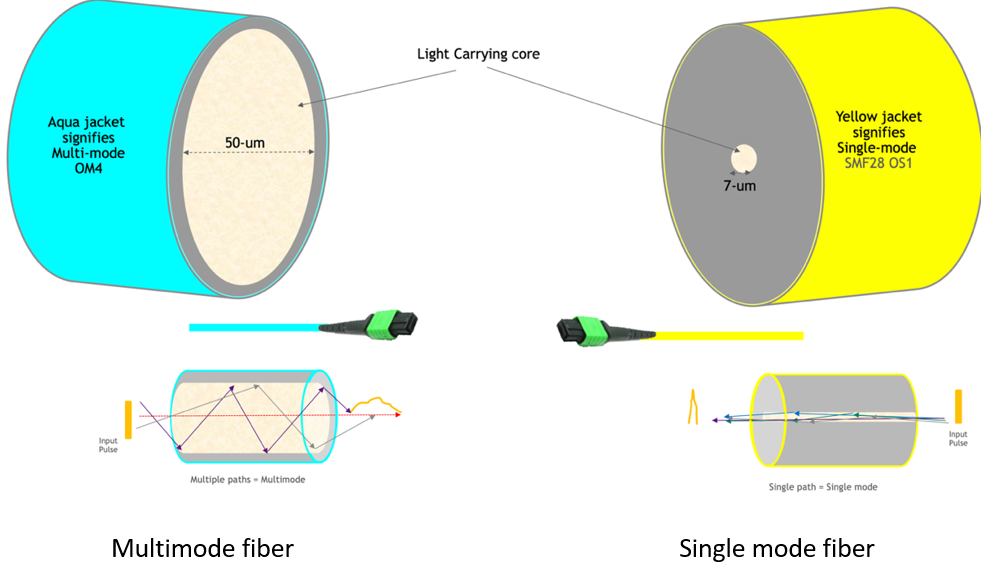Single-mode and Multimode Optical Fibers
NVIDIA sells optical fiber cables based on 4-channels of 100G-PAM4 only. These fibers are specific to the 100G-PAM4 NVIDIA offering for NDR InfiniBand and Spectrum Ethernet. The fibers are crossover Type-B fibers that enable directly linking two transceivers together. NVIDIA offers these and 1:2 splitter fiber cables from 1m to 100m in straight single mode and 1m to 50m for multimode and single mode splitters.
Not offered by NVIDIA are cables using 2-fiber LC, MPO-12/UPC, MPO-16/APC and other fiber cables and splitter cables. NVIDIA recommends sourcing these from numerous third-party suppliers as they are a commodity.
Optical fiber consists of a strand of glass with the outside coating glass a higher density than the inside. This confines the light to travel down the length of the fiber and bending when encountering the higher density glass coating.
There are two types of fibers: single-mode and multimode.
Single-mode fiber has a tiny 9-um light carrying core. This is small enough to make the light bends inside at a very shallow angle which keeps the data pulse light photon packets together as a group or “single mode” which can travel over great distances.
Typically used for long reaches 50-meter to 40km but can be used for shorter 1m lengths.
Single-mode fiber for data centers is optimized to be most transparent at 1310nm wavelength.
The fiber cable jacket is usually colored yellow, and the transceiver pull tabs yellow.
Multimode fiber has a larger 50-um light carrying core and some of the photons in a single data pulse take steeper angles traveling down the fiber. This causes the light pulse to scatter inside the fiber into multiple paths or “multi(ple)modes” with some parts of the pulse taking longer to arrive at the end at the photodetector. This results in the pulse intensity weakening and spreading out in time enough to collide with the next following data pulse which limits the maximum reach.
Multimode fiber is optimized to be most transparent at 850-nm wavelength.
Multimode fibers and transceivers based on 850nm cannot operate with 1310nm single-mode fibers and transceivers.
The fiber cable jacket is usually colored aqua, and transceiver pull tabs tan.
Fiber type is optimized for specific modulation speeds:
For 25G-NRZ and 50G-PAM4: OM4 fiber type can reach up to 100-meters and OM3 for up to 70-meters.
For 100G-PAM4: OM4 fiber type can reach up to 50-meters and OM3 for up to 30-meters.
NVIDIA supplies fiber cables for the 100G-PAM4 line only up to 50-meters multimode and 100-meters single mode for straight fibers, and up to 50-meters for both single-mode and multimode 1:2 splitter fiber cables.
NVIDIA supplied fiber cables are MPO-12/APC only and use a green connector plastic shell for both single-mode and multimode optics.
The large diameter of multimode fiber is easy and inexpensive to connect lasers and photodetectors to and less expensive in building transceivers, but it is limited at 100G-PAM4 speeds to 50 meters. Single-mode fiber is more expensive to interface to but can reach beyond 2 kilometers – spanning entire data centers. Multimode optics are the most used optics as most data center interconnects are less than 50 meters.
Multimode and Single-mode fibers
